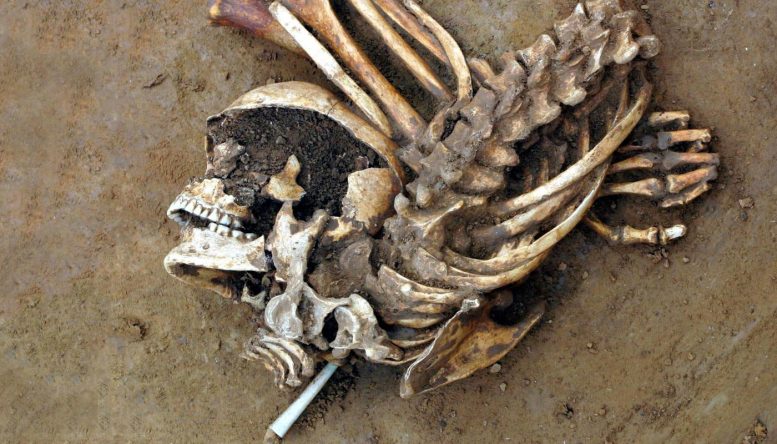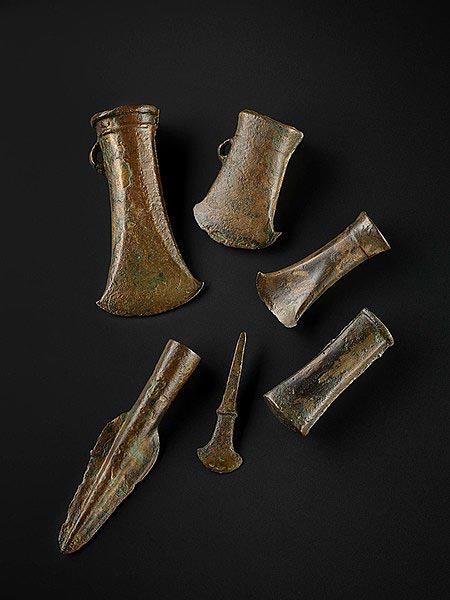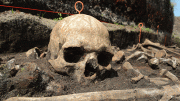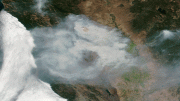
A photograph of the skeleton of one of the four individuals who we have sequenced who we think is likely to have participated in the migration we detect into southern Britain and to have displaced half the ancestry of the local population. This skeleton was excavated from the site of Cliffs End Farm in Kent. Credit: Wessex Archaeology
A major new study of ancient DNA has traced the movement of people into southern Britain during the Bronze Age.
A major new study of ancient DNA has traced the movement of people into southern Britain during the Bronze Age.
In the largest such analysis published to date, scientists examined the DNA of nearly 800 ancient individuals
The new study, led by the University of York, Harvard Medical School, and the University of Vienna, shows that people moving into southern Britain around 1300‒800 BC were responsible for around half the genetic ancestry of subsequent populations.

This image is of bronze age tools from the National Museums of Scotland, which could give readers a sense of the material culture associated with people who lived at the time of the migration. Credit: Bronze Age tools curated the National Museums of Scotland
The combined DNA and archaeological evidence suggests that, rather than a violent invasion or a single migratory event, the genetic structure of the population changed through sustained contacts between mainland Britain and Europe over several centuries, such as the movement of traders, intermarriage, and small scale movements of family groups.
The study finds evidence that the new migrants became thoroughly mixed in to the Southern British population in the period 1000‒875 BC.
The researchers say the origin of these migrants cannot yet be established with certainty, but they are most likely to have come from communities in and around present-day France.
The Middle to Late Bronze Age was a time when settled farming communities expanded across the landscapes of southern Britain, and extensive trade routes developed to allow the movement of metal ores for the production of bronze.
These new networks linked wide-ranging regions across Europe, as seen from the spread of bronze objects and raw materials.
The study’s lead archaeologist Professor Ian Armit, from the University of York, said: ‘We have long suspected, based on patterns of trade and shared ideologies, that the Middle to Late Bronze Age was a time of intense contacts between communities in Britain and Europe.
“While we may once have thought that long-distance mobility was restricted to a few individuals, such as traders or small bands of warriors, this new DNA evidence shows that considerable numbers of people were moving, across the whole spectrum of society.”
Some of the earliest genetic outliers have been found in Kent, suggesting that the south-east may have been a focus for movement into Britain. This resonates with previously published isotope evidence from archaeological sites like Cliffs End Farm, where some individuals were shown to have spent their childhoods on the Continent.
The new DNA evidence may also shed light on the long-standing question of when early Celtic languages arrived in Britain.
Since population movement often drives linguistic change, the new DNA evidence significantly strengthens the case for the appearance of Celtic languages in Britain in the Bronze Age. Conversely, the study shows little evidence for large-scale movements of people into Britain during the subsequent Iron Age, which has previously been thought of as the period during which Celtic languages may have spread.
Professor David Reich, from Harvard Medical School, said: “These findings do not settle the question of the origin of Celtic languages into Britain. However, any reasonable scholar needs to adjust their best guesses about what occurred based on these findings.
“Our results militate against an Iron Age spread of Celtic languages into Britain – the popular “Celtic from the East” hypothesis – and increase the likelihood of a Late Bronze Age arrival from France, a rarely discussed scenario called “Celtic from the Centre.”
A further unexpected finding of the study is a large increase in the frequency of the allele for lactase persistence (a genetic adaptation that allowed people to digest dairy products) in Bronze Age populations in Britain relative to the Continent.
Co-senior author of the study Professor Ron Pinhasi, a physical anthropologist and ancient DNA specialist from the University of Vienna, said “This study increases the amount of ancient DNA data we have from the Late Bronze and Iron Age in Britain by twelvefold, and Western and Central Europe by 3.5-fold.
“With this massive amount of data, we have for the first time the ability to carry out studies of adaptation with enough resolution in both time and space to allow us to discern that natural selection occurred in different ways in different parts of Europe.
“Our results show that dairy products must have been used in qualitatively different ways from an economic or cultural perspective in Britain than they were on the European continent in the Iron Age, as this was a time when lactase persistence was rising rapidly in frequency in Britain but not on the Continent.”
Although the new DNA evidence sheds most light on Britain, the data also indicate population movements between different parts of continental Europe, confirming what archaeologists have long suspected – that the Late Bronze Age was a period of intense and sustained contacts between many diverse communities.
Reference: “Large-scale migration into Britain during the Middle to Late Bronze Age” by Nick Patterson, Michael Isakov, Thomas Booth, Lindsey Büster, Claire-Elise Fischer, Iñigo Olalde, Harald Ringbauer, Ali Akbari, Olivia Cheronet, Madeleine Bleasdale, Nicole Adamski, Eveline Altena, Rebecca Bernardos, Selina Brace, Nasreen Broomandkhoshbacht, Kimberly Callan, Francesca Candilio, Brendan Culleton, Elizabeth Curtis, Lea Demetz, Kellie Sara Duffett Carlson, Daniel M. Fernandes, M. George B. Foody, Suzanne Freilich, Helen Goodchild, Aisling Kearns, Ann Marie Lawson, Iosif Lazaridis, Matthew Mah, Swapan Mallick, Kirsten Mandl, Adam Micco, Megan Michel, Guillermo Bravo Morante, Jonas Oppenheimer, Kadir Toykan Özdoğan, Lijun Qiu, Constanze Schattke, Kristin Stewardson, J. Noah Workman, Fatma Zalzala, Zhao Zhang, Bibiana Agustí, Tim Allen, Katalin Almássy, Luc Amkreutz, Abigail Ash, Christèle Baillif-Ducros, Alistair Barclay, László Bartosiewicz, Katherine Baxter, Zsolt Bernert, Jan Blažek, Mario Bodružić, Philippe Boissinot, Clive Bonsall, Pippa Bradley, Marcus Brittain, Alison Brookes, Fraser Brown, Lisa Brown, Richard Brunning, Chelsea Budd, Josip Burmaz, Sylvain Canet, Silvia Carnicero-Cáceres, Morana Čaušević-Bully, Andrew Chamberlain, Sébastien Chauvin, Sharon Clough, Natalija Čondić, Alfredo Coppa, Oliver Craig, Matija Črešnar, Vicki Cummings, Szabolcs Czifra, … Clive Waddington, Paula Ware, Paul Wilkinson, Linda Wilson, Rob Wiseman, Eilidh Young, Joško Zaninović, Andrej Žitňan, Carles Lalueza-Fox, Peter de Knijff, Ian Barnes, Peter Halkon, Mark G. Thomas, Douglas J. Kennett, Barry Cunliffe, Malcolm Lillie, Nadin Rohland, Ron Pinhasi, Ian Armit and David Reich, 22 December 2021, Nature.
DOI: 10.1038/s41586-021-04287-4









Are all the Reichs loud mouthed opinionaters?
It’s not old enough, the Minoans of Crete were mining Tin to make bronze out of Cornwall from 3500Bce-1450Bce. They Navigated the Atlantic Ocean and sailed up the Mississippi harvesting 500 million tons of copper out of northern Michigan and lake superior, in 2500BCE they built a stone Hendge on beaver island in the middle of lake superior.
The Muskogee Nation along the Missouri river are the remnant progeny of some of these early sailors. The sailors would travel down the Mississippi, around Florida, up the coast and around the north sea to the ornkie islands and stop in Bri Tin the land of Tin to haul through the pillars of Hercules between Spain and Morocco and provide Egypt with Bronze tools for cut saws to quarry the large blocks that currently make up most of the buildings in Egypt. For grain mostly, cattle hides, gold, silver and pottery. Most of the Pharoah’s in the old kingdom have tobacco leaves in their tombs.
There are two versions of history. One a false narrative concocted by the Smithsonian and Oxford so the London Quarter could financially exploit every sovereign nation in the world through it’s proxy the Dutch east india trading company. And two the real factual information that prior to 1450bce the Minoans of Crete had a world wide maritime shipping monopoly and exploited every nation on the Globe from 3500B.C.E. until 1450bce when Thera a small island 80 miles north of Crete decided to start to smoke then in a matter of days drop the super volcanic crater into the ocean and explode the biggest super volcanic eruption in all of human history. It caused a tsunami 80 feet high and they still are finding sea shells on Crete to this day in the high hills.
When the Minoans from the Muskogee Nation returned and the various other settlements in Britain and other mining groups their homeland was completely destroyed these sea people went on the war path with everyone in the Mediterranean the Greeks fell, the hittites fell, the Israelites fell, the babylonians fell, only the Egyptians held fast by Ramses the third. The eruption on thera caused the bronze age collapse and it’s liable to happen again.
The XH hologroup of the Crete Sailors is undeniable. There was massive amounts of migrations into the Mississippi valley and Missouri River deltas long before Columbus or even the Vikings ventured into New Foundland.
Ever heard the song Cherokee people? Like the Mississippi river valley was home to all kinds of strange people Ibirians, Hindus, Blacks, Egyptians, and they all got interwoven with the natural inhabitants. They were Crete slave laborers or if not slaves hired hands.
Best of luck with your research but the world is alot older than 4,000 years.
Thank you for this study, and for the report about it. It is great that people are doing serious work, retrieving and studying the genetic evidence, increasing our knowledge of population geneses and evolution, and reassessing older theories about cultural origins and proposing new ones. Thanks, I do appreciate it.